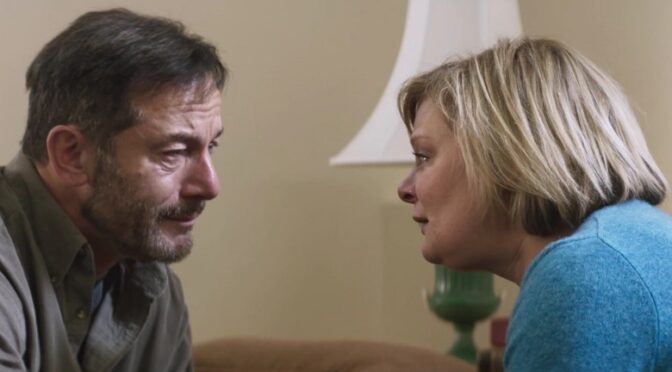 Fran Kranz’s intense chamber piece is a devastating and formally accomplished story on the nature of forgiveness, guilt and vindictiveness. The impassioned yet restrained performances are deservedly attention-grabbing, yet Kranz’s precise choreography and intelligent use of space is the force which gives MASS its weight.
Fran Kranz’s intense chamber piece is a devastating and formally accomplished story on the nature of forgiveness, guilt and vindictiveness. The impassioned yet restrained performances are deservedly attention-grabbing, yet Kranz’s precise choreography and intelligent use of space is the force which gives MASS its weight.
The film begins with Kendra (Michelle N. Carter) fussing over a room in a church, clearly being set up for some sort of conflict resolution session. Two couples dealing with a tragedy arrive to meet there: Jay and Gail (Jason Isaacs and Martha Plimpton), and Linda and Richard (Ann Dowd and Reed Birney). To give any further details would steal one of the film’s pleasures away, which is the superbly paced script which gradually unfurls how these couples come to be there and the elements which fill in their stories before this day.
For the rest of the film’s runtime, we primarily stay within that room, following the conversation and visually studying the characters’ movements and body language. As with any single-location film, it runs the risk of feeling thematically claustrophobic as well as literally. However, both the visuals and the script work hard to naturally cover an expansive set of subjects (albeit in a very staged pressure cooker of a setup).
The cast conveys emotions with measured and skilled performances. In dealing with grief, guilt and anger, there are, of course, monologue opportunities, delivered with the raw vocal emotion you would expect. Still, these gather most of their impact from the accumulation of small gestures or precisely placed physical acts: Martha Plimpton defensively folding her arms; Jason Isaacs standing up abruptly from the table seating and nervously pacing; Reed Birney leaning back in his chair; Ann Dowd sincerely widening her eyes.
All this is calibrated to blend with Kranz’s direction and the broader technical elements of the film. The conversation’s mood and dynamics are represented in the character locations; the cast begins centrally and seated together and then moving through various configurations, the most extreme being when all four gradually retreat to different corners of the room. In parallel, the shot choices sometimes do the heavy lifting, leaving characters out of focus in the background or off centre in the frame. The editing and camera movements also heighten the conversation’s impact: at one stage a slow pan across the table is broken by an abrupt jump cut to the path’s end as a character breaks into tears.
MASS achieves this without turning its single location into a literal echo chamber for liberal frustrations. The film alludes to the gun control debate in the USA. Still, it is keen to shift the focus to the processing of emotions and humanity, which directors or writers often remove by using characters as mere vehicles for sparring polemical soliloquies. Rather than taking a top-down approach and beginning with the broader problems and issues, MASS is instead bottom-up: beginning with characters, deeply affected by those issues, in which we can invest.
The densely-packed emotional energy of MASS is absorbing, and the film is a beautiful example of acting and filmmaking coming together to sharpen the work as a whole.

